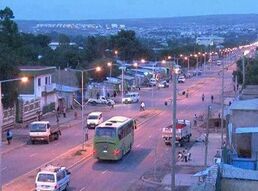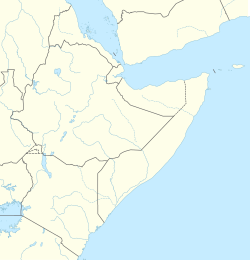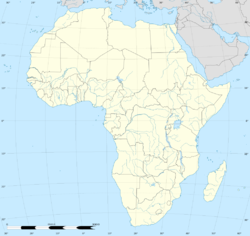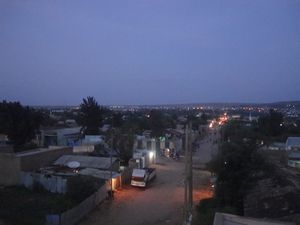جيكجيكا
جيگجيگا
Laaca | |
|---|---|
From left: Dusk view of Jijiga; Outskirt of Jijiga; Metropolis of Jijiga; Jigjiga's camel transportation; Sayyid Mohammed Statue | |
| الإحداثيات: 9°21′N 42°48′E / 9.350°N 42.800°E | |
| البلد | |
| الإقليم | صومالي |
| المقاطعة | جيگجيگا |
| Zone | Fafan |
| الحكومة | |
| • الرئيس | عبدي محمود عمر |
| • العمدة | عبد الحكيم حاديس ضاهر |
| المنسوب | 1٬609 m (5٬279 ft) |
| التعداد (2007)[1] | |
| • الإجمالي | 203٬588 |
| • Estimate (2021) | 483٬000 |
| منطقة التوقيت | UTC+3 (توقيت شرق أفريقيا) |
جيگجيگا Jijiga (صومالية: Jigjiga)، هي مدينة في شرق إثيوپيا وعاصمة إقليم صومالي. تقع المدينة في مقاطعة جيگجيگا على بعد حوالي 80 كمن شرق هرر و60 كم غرب الحدود مع الصومال، تقع المدينة على إرتفاع 1.609 متر فوق سطح البحر.
تقع المدينة على الطريق الرئيسي بين هرر ومدينة هرجيسا الصومالية، وكانت قد تأسست على يد قبائل اليابار والبارتيس الصومالية والتي تشتهر بانتاج البخور. تتمتع جيگجيگا بخدمات البريد منذ عام 1923، وخدمة الهاتف من عام 1956.[2] يوجد طريق اسفلتي وخرساني بإمتداد 170 كم يصل جيگجيگا ودگهابور اكتمل انشاءه في 14 نوفمبر 2008 بتكلفة 230 مليون بير.[3] يخدم المدينة مطار جيگجيگا (مطار گراد ويل-وال) (IATA: JIJ, ICAO: HAJJ).
كانت جيگجيگا تابعة لولاية هررغه، لكن بعد تبني الدستور الإثيوپي 1995، أصبحت عاصمة لمنطقة صومالي.
التاريخ
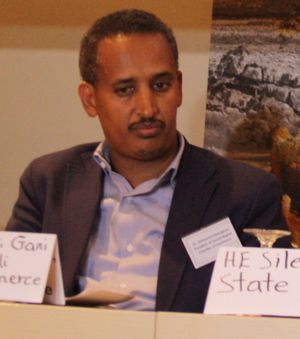
The region around Jijiga is believed to be associated with the medieval Gidaya state which existed as early as thirteenth century.[4] One of the earliest references to Jijiga comes from W.C. Barker in 1842 who mentions it as one of the mahalla or halting-places of the caravan route between Zeila and Harar.[5] Jijiga was later mentioned by British traveler Richard Francis Burton in 1854, who reports that it was a centre of wells for pastoralists of the local Somali (Jidwaq) clan on the caravan route to Berbera.[6]
Ethiopian imperial expansion into the Ogaden led to the establishment of a garrison camp at Jijiga in 1891, which later became a base for military campaigns into the Somali-inhabited lowlands. British hunter Colonel Swayne, who passed through Jijiga in February 1893, which he described as a stockaded fort with a garrison of 25 men next to a group of wells.[7][8]
Abdullah Tahir was appointed governor of Jigjiga in 1896, this would be the emergence of Jigjiga's urban development.[9][10] Governor Tahir set up round the clock security forces to protect the town which consisted mainly of Somalis and Harari people as the Dervish militia had begun its activities in the region.[11] According to I. M. Lewis, the Dervish[12] invaded Jijiga in March 1900. Although the Dervishes suffered heavy losses, which allowed the Ethiopian authorities to declare a victory, Sayyid Mohammed's men recovered livestock that the Ethiopians had taken from the Somalis and proved that his was a force to be reckoned with.[13]
Succeeding governors such as Fitawrari Tekle Hawariat Tekle Mariyam, had the town methodically organized in a square grid of streets, built a fort, dug several wells, encouraged agriculture, and set a fixed land tax. Actions which won the hearts of the Ogaden Somalis.[14]
During the Second Italo-Ethiopian War, Jijiga served for some time as Dejazmach Nasibu Emmanual's headquarters and a supply center for the Ethiopian army. An Italian force under Colonel Navarra occupied the city on the evening of 5 May 1936.[2] Two days later, while inspecting a ruined Ethiopian Orthodox church in the city, Marshal Rodolfo Graziani fell into a concealed hole, which he was afterwards convinced was a mantrap; Anthony Mockler suggests this mishap contributed to his murderously paranoid mindset which led to the atrocities that followed the attempt on Graziani's life 19 February 1937.[15]
البريطاني
On 17 March 1941, during the East African Campaign of World War II, Jijiga was occupied by the 23rd Nigerian Brigade of the British 1st African Division. This was after the Italian garrison had already abandoned the city.[16] Once they had possession of Jijiga, however, the British were slow in returning the city to the Ethiopians. At first, it was included as part of The Reserved Area, as defined in the Anglo-Ethiopian Agreement of 31 January 1942, which also included much of the Haud. Only after patient pressure from Emperor Haile Selassie did the two countries begin to discuss an agreement for the evacuation of the British from this territory in 1948. Although Ethiopian officers began to take over the administration from British officers in May–July, the protocol agreeing to the transfer was not signed until 24 July of that year. A brief demonstration of overt Somali nationalism occurred in Jijiga when the Somali Youth League (SYL) raised their flag before their headquarters in defiance of the law and the new Ethiopian administrators. Major Demeka, the governor-designate of the Ogaden Province, requested the British military administration, which was still in charge, to remove the flag. When the leaders refused to pull down their flag, the police brought it down with a machine gun mounted on an armored car. In the disturbances that followed, one policeman was killed and another wounded while the police opened fire on the crowd and killed 25 of them. The SYL was proscribed shortly afterward in Ethiopia.[2]
التسليم
Germame Neway, one of the leaders of the unsuccessful 1960 coup, served as governor over Jijiga in 1959. He had been transferred there for his civic responsibility and concern for the underprivileged while administering a district in Sidamo Province. The obstruction he encountered, not only in Sidamo but in Jijiga, convinced him of the need for radical measures.[17] In the early stage of the Ethiopian Revolution individual units from the Third Division put the local governor under house arrest around 13 April 1974.[2] During the Ogaden War, Jijiga experienced the Battle of Jijiga and was occupied by the Western Somali Liberation Front's Ahmad ibn Ibrihim al-Ghazi division led by Col. Yusuf Dheere, later with the Somali National Army, from September 1977 until February/March 1978.
The Regional government held a conference in this city to promote peace and development between 10 and 13 March 1996, which was attended by 535 from the local woredas, as well as the Deputy Prime Minister and Defense Minister of Ethiopia, Tamirat Layne, the Foreign Minister, Seyoum Mesfin, the presidents of the Tigray and Harari Regional states and representatives from Amhara and the Southern Nations, Nationalities, and People's Regions.[18] On 28 May 2007, during the celebration of Ginbot 20 (celebrating the downfall of the Derg), Jijiga and Degehabur were the scenes of attacks on civilians and government officials. At least 16 people were killed and 67 injured, including Abdulahi Hassan Mohammed, president of the Somali Region, who was speaking at the ceremony. The Ethiopian government blamed the attack on the Ogaden National Liberation Front.[19]
On 29 May 2008, following a heavy downpour the Jijiga River broke its banks and flooded several kebeles in the town and the vicinity. The flooding killed 29 people and displaced 350 households.[20] On 27 September of that year, a bomb exploded outside a hotel in Jijiga killing four and wounding 20. Local police apprehended a suspect whom they claimed was a member of Al-Itihaad al-Islamiya.[21]
السكان
Based on the 2007 Census conducted by the Central Statistical Agency of Ethiopia (CSA), Jijiga had a total population of 203,588 of whom 109,138 were men and 94,450 women. Ethnic groups in the city include the Somali (168,551, 82.79%), Amhara (16,837, 8.27%), Oromo (8,775, 4.31%), and Gurage (4,379, 2.15%); all other groups made up 2.48% of the total population.[23] Members of Somali clans in this city include the Jidwaaq, Akisho, Ogaden, Geri Koombe, and the Sa'ad Musa subclan of the Habr Awal, with a minor presence of some other clans like the Gadabursi and Sheekhaal.[بحاجة لمصدر]
The results of the 1994 census in the Somali Region were not satisfactory, so the census was repeated in 1997. This census reported this town had a total population of 65,795 of whom 33,266 were male and 32,529 female. The predominant religion in this city Jijiga is Muslim. As of 1997, the ethnic composition of the town was 61.58% Somali, 23.25% Amhara, 7.32% Oromo and 4.37% Gurage, and 1.48% Tigrayan; all other ethnic groups made up 1.99% of the population.[24] This city is the largest in the whole Somali region.[25]
المناخ
The climate of Jijiga is a subtropical highland climate (Köppen climate classification: Cwb). extremely wet and lush during rainy season, as with the rest of the Ethiopian highlands, Seasonal differences relate only to rainfall, as temperatures year-round are cool to mild in the mornings and uniformly very warm though not hot during the afternoons.
There are two rainy seasons: the main meher rains occur from July to September, and the short belg rains in April and June. The dry season, known as bega, is cooler by morning than the wet seasons due to lower cloud cover, but equally hot by afternoon though less humid.
| أخفClimate data for جيگجيگا | |||||||||||||
|---|---|---|---|---|---|---|---|---|---|---|---|---|---|
| Month | Jan | Feb | Mar | Apr | May | Jun | Jul | Aug | Sep | Oct | Nov | Dec | Year |
| Mean daily maximum °C (°F) | 25.8 (78.4) |
26.7 (80.1) |
28.2 (82.8) |
26.7 (80.1) |
27.3 (81.1) |
26.7 (80.1) |
25.6 (78.1) |
25.9 (78.6) |
26.5 (79.7) |
26.7 (80.1) |
26.2 (79.2) |
25.6 (78.1) |
26.5 (79.7) |
| Daily mean °C (°F) | 16.4 (61.5) |
18.4 (65.1) |
20.3 (68.5) |
20.2 (68.4) |
20.9 (69.6) |
21.1 (70.0) |
20.5 (68.9) |
20.6 (69.1) |
20.7 (69.3) |
18.9 (66.0) |
17.4 (63.3) |
16.9 (62.4) |
19.4 (66.8) |
| Mean daily minimum °C (°F) | 7.1 (44.8) |
10.2 (50.4) |
12.4 (54.3) |
13.7 (56.7) |
14.6 (58.3) |
15.5 (59.9) |
15.5 (59.9) |
15.3 (59.5) |
14.9 (58.8) |
11.2 (52.2) |
8.7 (47.7) |
8.2 (46.8) |
12.3 (54.1) |
| Average rainfall mm (inches) | 11 (0.4) |
25 (1.0) |
47 (1.9) |
105 (4.1) |
93 (3.7) |
56 (2.2) |
84 (3.3) |
127 (5.0) |
101 (4.0) |
41 (1.6) |
16 (0.6) |
6 (0.2) |
712 (28) |
| Average relative humidity (%) | 49.4 | 46.7 | 51.7 | 61.6 | 63.1 | 64.5 | 63.9 | 64.1 | 62.7 | 57.7 | 49.9 | 50.3 | 57.1 |
| [بحاجة لمصدر] | |||||||||||||
البيئة
The vegetation is a grassland from the east and south of the city towards wajaale, with Pockets of juipars and gum forest in higher altitudes in the northern and western part of the city, there is extensive history of animal life in the past. For example, the area was earlier a habitat for the African wild dog, Lycaon pictus,[27] although this canid is likely extirpated at present in the local area, due to an expanding human population.
In his memoirs of his homeland, Nega Mezlekia describes Jijiga as sitting "on the edge of a vast, unmitigated valley on the bottom of Mount Kramanda the beginning of the mighty Ethiopian highlands, with vast lush greenery in sight, rolling hills and plains dotted with many farms in all directions the soaring Eastern Ethiopian Highlands slowly climbing west, the very common tall grassland tree used as shelter by the wandering hyena, and the inevitable sacred tree in every compound, trees in this area of the Somali region reach great heights with the help of generous rainfall year-round, the native Somalis in the area would use this area as a dry season grazing land for all the noble tribes of the land. The city is surrounded by rocky tall green mountains on all sides save the north all the way past nearby Harar all the way to Addis, which is open as far as the eye can see."[28]
الهوامش
- ^ "Population and Housing Census 2007 – Somali Statistical" (PDF). Ethiopia Statistics Agency. 2007. Retrieved 31 May 2022.
- ^ أ ب ت ث "Local History in Ethiopia" The Nordic Africa Institute website (accessed 31 May 2008) خطأ استشهاد: وسم
<ref>غير صالح؛ الاسم "NAI-web" معرف أكثر من مرة بمحتويات مختلفة. - ^ "Jijiga-Degehabur asphalt road open for traffic", Ethiopian News Agency website (accessed 20 January 2010)
- ^ Braukamper, Ulrich (2002). Islamic History and Culture in Southern Ethiopia. Lit. p. 34. ISBN 9783825856717.
- ^ "Extract Report on the Probable Geographical Position of Harrar; With Some Information Relative to the Various Tribes in the Vicinity", Journal of the Royal Geographical Society, 12 (1842), p. 244
- ^ Burton, Richard (1894). First Footsteps in East Africa. Tylston and Edwards. p. 192.
- ^ H. G. C. Swayne, "A Trip to Harar and Imé", Geographical Journal, 2 (September 1893), p. 251
- ^ Gebresenbet, Fana. Perishable state-making: Vegetable trade betweenself-governance and ethnic entitlement in Jigjiga,Ethiopia (PDF). Danish Institute for International Studies (DIIS). p. 5.
- ^ Gebresenbet, Fana. Perishable state-making: Vegetable trade betweenself-governance and ethnic entitlement in Jigjiga,Ethiopia (PDF). Danish Institute for International Studies (DIIS). p. 5.
- ^ Emmenegger, Rony (22 June 2023). Urban Planning and the Contemporary Dynamics of Land Formalization in the City of Jigjiga. Corne de l'Afrique contemporaine / Contemporary Horn of Africa. Centre français des études éthiopiennes. pp. 345–354. ISBN 9782111723146.
- ^ Proceedings of the Fourth Seminar of the Department of History (Awasa, 8-12 July 1987). Addis Ababa University. 1989. p. 158.
- ^ Omar, Mohamed (2001). The Scramble in the Horn of Africa. p. 402.
This letter is sent by all the Dervishes, the Amir, and all the Dolbahanta to the Ruler of Berbera ... We are a Government, we have a Sultan, an Amir, and Chiefs, and subjects ... (reply) In his last letter the Mullah pretends to speak in the name of the Dervishes, their Amir (himself), and the Dolbahanta tribes. This letter shows his object is to establish himself as the Ruler of the Dolbahanta
- ^ I. M. Lewis, A Modern History of the Somali, fourth edition (Oxford: James Currey, 2002), p. 71.
- ^ Richard Pankhurst, Economic History of Ethiopia (Addis Ababa: Haile Selassie University, 1968), p. 621
- ^ Anthony Mockler, Haile Selassie's War (New York: Olive Branch, 2003), p. 144
- ^ Mockler, pp. 365f
- ^ Bahru Zewde, A History of Modern Ethiopia: 1855-1991, 2nd edition (Oxford: James Currey, 2001), p. 213
- ^ Report on the Peace and Development Conference Jigjiga, 10-13 March 1996 UNDP Emergencies Unit for Ethiopia report, April 1996 (accessed 26 December 2008)
- ^ Many killed in Ethiopia attacks (al Jazeera)
- ^ "Focus On Ethiopia, February 2008", UN-OCHA website (accessed 19 March 2009)
- ^ "2008 Human Rights Reports: Ethiopia", Bureau of Democracy, Human Rights, and Labor, US State Department (accessed 8 July 2009)
- ^ Summary and Statistical Report of the 2007 Population and Housing Census (PDF). Central Statistical Agency. 2008. pp. 106–108.
- ^ Summary and Statistical Report of the 2007 Population and Housing Census (PDF). Central Statistical Agency. 2008. pp. 106–108.
- ^ 1994 Population and Housing Census of Ethiopia: Results for Somali Region, Vol. 1] "Archived copy" (PDF). Archived from the original on 2008-11-19. Retrieved 2009-03-23.
{{cite web}}: CS1 maint: archived copy as title (link) CS1 maint: bot: original URL status unknown (link) Tables 2.4, 2.14 (accessed 10 January 2009). - ^ Carruth, Lauren (2021). Love and Liberation: Humanitarian Work in Ethiopia's Somali Region. Cornell University Press. ISBN 978-1-5017-5966-6. JSTOR 10.7591/j.ctv1gbrwvc.
- ^ "Climate Data : Ethiopia". Retrieved 10 May 2013.
{{cite web}}: Unknown parameter|deadurl=ignored (|url-status=suggested) (help) - ^ C. Michael Hogan. 2009. Painted Hunting Dog: Lycaon pictus, GlobalTwitcher.com, ed. N. Stromberg Archived 2010-12-09 at the Wayback Machine
- ^ Nega Mezlekia, Notes from the Hyena's Belly: An Ethiopian Childhood (New York: Picador,2000), p. 5. ISBN 0-312-28914-6
وصلات خارجية
- Cities of Ethiopia: Jijiga by John Graham (Addis Tribune, 28 December 2001)
- CS1 maint: bot: original URL status unknown
- CS1 errors: unsupported parameter
- Pages using gadget WikiMiniAtlas
- Short description is different from Wikidata
- Pages using multiple image with auto scaled images
- Articles containing صومالية-language text
- Pages using Lang-xx templates
- مقالات ذات عبارات بحاجة لمصادر
- Articles with unsourced statements from July 2012
- Coordinates on Wikidata
- أماكن مأهولة في إقليم صومالي
- Cities and towns in Ethiopia
